Segmentation of Potato Consumers Based on Sensory and Attitudinal Aspects †
Abstract
1. Introduction
2. Materials and Methods
2.1. Sample Preparation and Serving
2.2. Participants Recruitment for Consumer Study
2.3. Questionnaire
2.4. Design of Experiment for Consumer Study
2.5. Statistical Analysis
3. Results
3.1. Segmentation of Potato Consumers
3.2. Preference Mapping for Each Obtained Segment
3.2.1. Internal Preference Mapping—Segment 1
3.2.2. Internal Preference Mapping—Segment 2
3.2.3. Internal Preference Mapping—Segment 3
3.3. Factors Affecting Purchase Decisions
3.4. Consumer Choice of Cooking Methods
3.5. Potato Variety Preference
3.6. Attitudes, Opinions and Perceptions
- Potatoes are nutritious (N = 95). Potatoes were found to be nutritious by 73% of total consumers, whereas 18% of consumers were found to have disagreement with this statement.
- Potatoes are boring and dull (N = 95). Only 5% of consumers agreed with this statement.
- Labeling about origin (such as Idaho, Colorado etc.) of potatoes influence my purchase decision (N = 95). Two distinct groups were observed with respect to this statement, as 44% respondents agreed whereas 40% disagreed.
- Labeling about variety name (such as Russet Norkotah, Snowden etc.) on the package influences my purchase decision (N = 95). A significant effect of variety name was observed on purchase decision, as 61% of respondents agreed with this statement while 24% disagreed.
- I believe that the flavor of potatoes has changed historically (N = 95). Respondents were found having no clear trend about this statement, as 29% agreed, whereas 28% disagreed. The highest percentage of the ‘neither agree nor disagree’ option was chosen by the respondents (43%) for the abovementioned statement, implying the lack of belief or relevance (understanding) of this statement.
- Potatoes are healthy regardless of the cooking method (N = 95). Overall, 68% of respondents disagreed with this statement while 24% agreed.
- I tend to buy organic products/ingredients (N = 95). Overall, 62% respondents disagreed with this statement while 23% agreed. Gender’s attitude differences with respect to food safety and environmental contamination could be considered by this statement, as female respondents were found less attentive towards these issues (67% were disagreed) compared to male respondents (58% disagreed).
- I tend to buy natural products or ingredients (N = 95). Natural product interest would indirectly measure the organic statement mentioned above. Overall, 38% respondents disagreed with this statement while 44% agreed. A higher percentage of female respondents compared to male respondents (22 vs. 14%) were found to have uncertainty about whether the product being organic would affect their purchase decision or not, as they selected ‘neither agree nor disagree’. Male respondents agreed with the statement significantly higher compared to female respondents (50 vs. 38%).
- I look for non-GMO (Genetically Modified Organisms) ingredients in the food I eat (N = 95). Higher proportion of respondents (46%) disagreed with the statement that they look for non-GMO ingredients in their food compared to those who agreed (38%). Male respondents disagreed with this statement significantly more than female respondents (52 vs. 40%, respectively).
- I avoid potatoes because they are high in carbohydrates (N = 95). Overall, 73% respondents disagreed while 20% agreed with the statement. Most of the respondents, irrespective of gender differences, were found to disagree (73% female vs. 72% male) with this statement.
4. Discussion
4.1. Segmentation of Potato Consumers
4.2. Factors Influencing Purchase Decisions
4.3. Potato Cooking Method and Convenience
4.4. Potato Variety Preference
4.5. Beliefs, Attitudes, Opinions, and Perceptions
5. Limitations of This Study
6. Conclusions
Supplementary Materials
Author Contributions
Funding
Acknowledgments
Conflicts of Interest
References
- Bamberg, J.; Greenway, G. Nutritional and economic prospects for expanded potato outlets. Am. J. Potato Res. 2019, 1–10. [Google Scholar] [CrossRef]
- Fearne, A. The great British potato: A study of consumer demand, attitudes and perceptions. Br. Food J. 1992, 94, 22–28. [Google Scholar] [CrossRef]
- Sharma, C. Sensory and Consumer Profiling of Potatoes Grown in the USA. Ph.D. Dissertation, Kansas State University, Manhattan, KS, USA, 2019. [Google Scholar]
- McGregor, I. Chapter 1—The Fresh Potato Market. In Potato Biology and Biotechnology; Vreugdenhil, D., Bradshaw, J., Gebhardt, C., Govers, F., Mackerron, D.K.L., Taylor, M.A., Ross, H.A., Eds.; Elsevier Science: Amsterdam, The Netherlands, 2007; pp. 3–26. [Google Scholar]
- Wood, K.; Carragher, J.; Davis, R. Australian consumers’ insights into potatoes-Nutritional knowledge, perceptions and beliefs. Appetite 2017, 114, 169–174. [Google Scholar] [CrossRef] [PubMed]
- Gray, E. An Investigation into the Decline in the Use of Fresh Potatoes and the Increased Demand for Processed Potato Products in the Foodservice Sector in the Leinster Area. Level 3 2018, 14, 9. [Google Scholar] [CrossRef]
- Attah, A.O.; Braaten, T.; Skeie, G. Change in potato consumption among Norwegian women 1998–2005—The Norwegian Women and Cancer study (NOWAC). PLoS ONE 2017, 12, e0179441. [Google Scholar] [CrossRef]
- Gareau, R.M. Proceedings from the 2014 Symposium: Bringing New Potato Products to Market. Am. J. Potato Res. 2018, 95, 101–109. [Google Scholar] [CrossRef]
- Fuller, K.B.; Brester, G.W.; Boland, M.A. Genetic Engineering and Risk in Varietal Selection of Potatoes. Am. J. Agric. Econ. 2018, 100, 600–608. [Google Scholar] [CrossRef]
- Fernqvist, F.; Spendrup, S.; Ekelund, L. Changing consumer intake of potato, a focus group study. Br. Food J. 2015, 117, 210–221. [Google Scholar] [CrossRef]
- Dukeshire, S.; MacPherson, M.; Veitch, S.; Wang-Pruski, G. Slicing, dicing, spicing, and pricing: Factors influencing purchase and consumption of fresh potatoes. J. Food Prod. Mark. 2016, 22, 240–257. [Google Scholar] [CrossRef]
- Morris, W.L.; Taylor, M.A. Improving Flavor to Increase Consumption. Am. J. Potato Res. 2019, 96, 195–200. [Google Scholar] [CrossRef]
- Karadas, K.; Kumlay, A.M.; Eyduran, E.; Gursoy, A.K. Identification of potato purchasing behaviors and preferences of consumers by means of robust factor analysis. Sci. Pap. Ser. Manag. Econ. Eng. Agric. Rural Dev. 2017, 17, 193–196. [Google Scholar]
- Jansky, S.H. Potato flavor. Am. J. Potato Res. 2010, 87, 209–217. [Google Scholar] [CrossRef]
- Bough, R.A.; Holm, D.G.; Jayanty, S.S. Evaluation of Cooked Flavor for Fifteen Potato Genotypes and the Correlation of Sensory Analysis to Instrumental Methods. Am. J. Potato Res. 2019, 97, 63–77. [Google Scholar] [CrossRef]
- Fernqvist, F. Chapter 20—Credence. In Methods in Consumer Research; Ares, G., Varela, P., Eds.; Woodhead Publishing: Cambridge, UK, 2018; Volume 1, pp. 531–555. [Google Scholar]
- Fitzsimmons, J.; Cicia, G. Different Tubers for Different Consumers: Heterogeneity in Human Values and Willingness to Pay for Social Outcomes of Potato Credence Attributes. Int. J. Food Syst. Dyn. 2018, 9, 354–374. [Google Scholar]
- Blythe, J. Consumer Behaviour; Cengage Learning EMEA: Boston, MA, USA, 2008. [Google Scholar]
- Cheng, H.; Peavey, S.; Kezis, A.S. Regional differences in consumer potato-purchasing decision in the eastern United States. Am. J. Potato Res. 2001, 78, 1–7. [Google Scholar] [CrossRef]
- Berget, I. Statistical approaches to consumer segmentation. In Methods in Consumer Research; Ares, G., Varela, P., Eds.; Woodhead Publishing: Cambridge, UK, 2018; Volume 1, pp. 353–382. [Google Scholar]
- Sharma, C.; Chambers, E., IV; Jayanty, S.; Sathuvalli, V.; Holm, D.; Talavera, M. Development of a lexicon to describe the sensory characteristics of a wide variety of potato cultivars. J Sens. Stud. 2020. [Google Scholar] [CrossRef]
- McGorrin, R.J. Character-impact flavor compounds. In Sensory-Directed Flavor Analysis; Marsili, R., Ed.; Taylor & Francis Group: Boca Raton, FL, USA, 2007; pp. 223–257. [Google Scholar]
- Yue, C.; Grebitus, C.; Bruhn, M.; Jensen, H.H. Potato Marketing–Factors Affecting Organic and Conventional Potato Consumption Patterns. In Proceedings of the European Association of Agricultural Economists (EAAE), 2008 International Congress, Ghent, Belgium, 26–29 August 2008. [Google Scholar]
- Jemison, J.M., Jr.; Sexton, P.; Camire, M.E. Factors influencing consumer preference of fresh potato varieties in Maine. Am. J. Potato Res. 2008, 85, 140–149. [Google Scholar] [CrossRef]
- Hine, S.E.; Loureiro, M.L.; Meyer, S.E. Marketing Colorado potatoes as a value-added product: A case study. J. Food Distrib. Res. 2001, 32, 45–53. [Google Scholar]
- McCracken, V.A.; Marotz, C.C. Consumer potato demand. J. Food Distrib. Res. 1989, 20, 1–12. [Google Scholar]
- Cook, K.A.; Toensmeyer, U.C.; German, C.L.; Bacon, J.R. An analysis of household consumption of fresh potatoes in Delaware. J. Food Distrib. Res. 2000, 31, 103–111. [Google Scholar]
- Peura-Kapanen, L.; Jallinoja, P.; Kaarakainen, M. Acceptability of convenience food among older people. Sage Open 2017, 7, 1–11. [Google Scholar] [CrossRef]
- Denver, S.; Jensen, J.D. Consumer preferences for organically and locally produced apples. Food Qual. Prefer. 2014, 31, 129–134. [Google Scholar] [CrossRef]
- Thompson, G.D.; Kidwell, J. Explaining the choice of organic produce: Cosmetic defects, prices, and consumer preferences. Am. J. Agric. Econ. 1998, 80, 277–287. [Google Scholar] [CrossRef]
- Chambers, E.V.; Chambers, E., IV; Castro, M. What is “natural”? Consumer responses to selected ingredients. Foods 2018, 7, 65. [Google Scholar] [CrossRef] [PubMed]
- Wunderlich, S.; Gatto, K.A. Consumer Perception of Genetically Modified Organisms and Sources of Information. Adv. Nutr. 2015, 6, 842–851. [Google Scholar] [CrossRef] [PubMed]
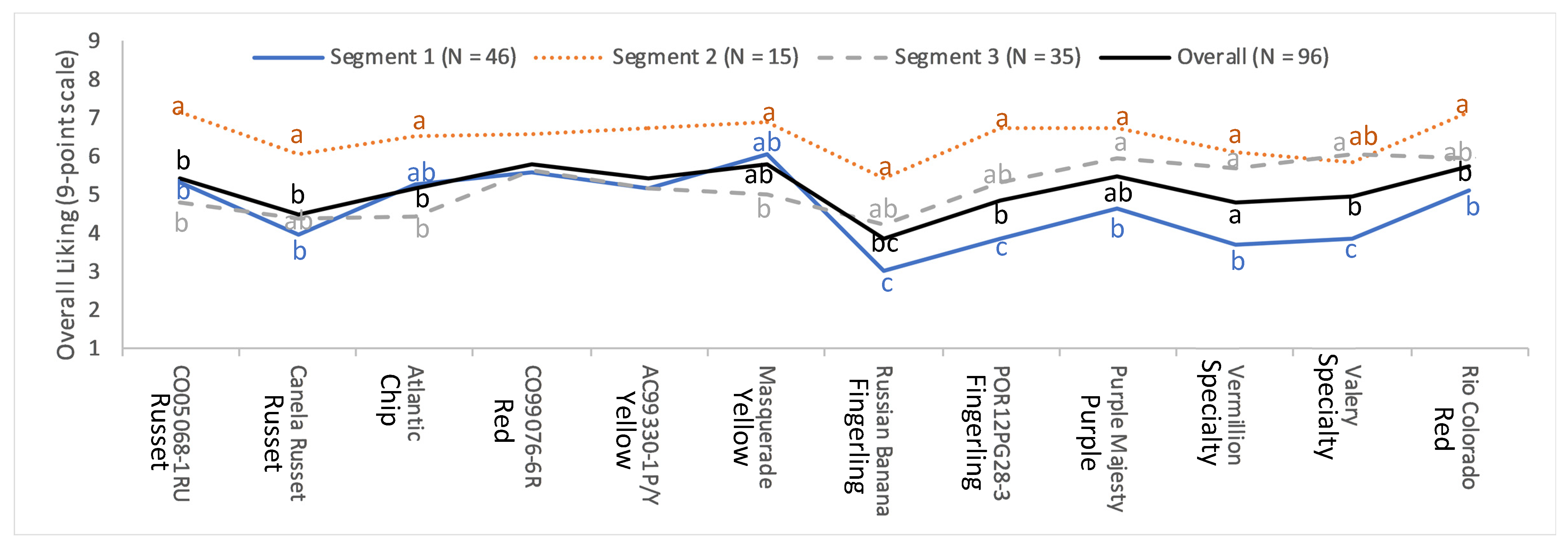
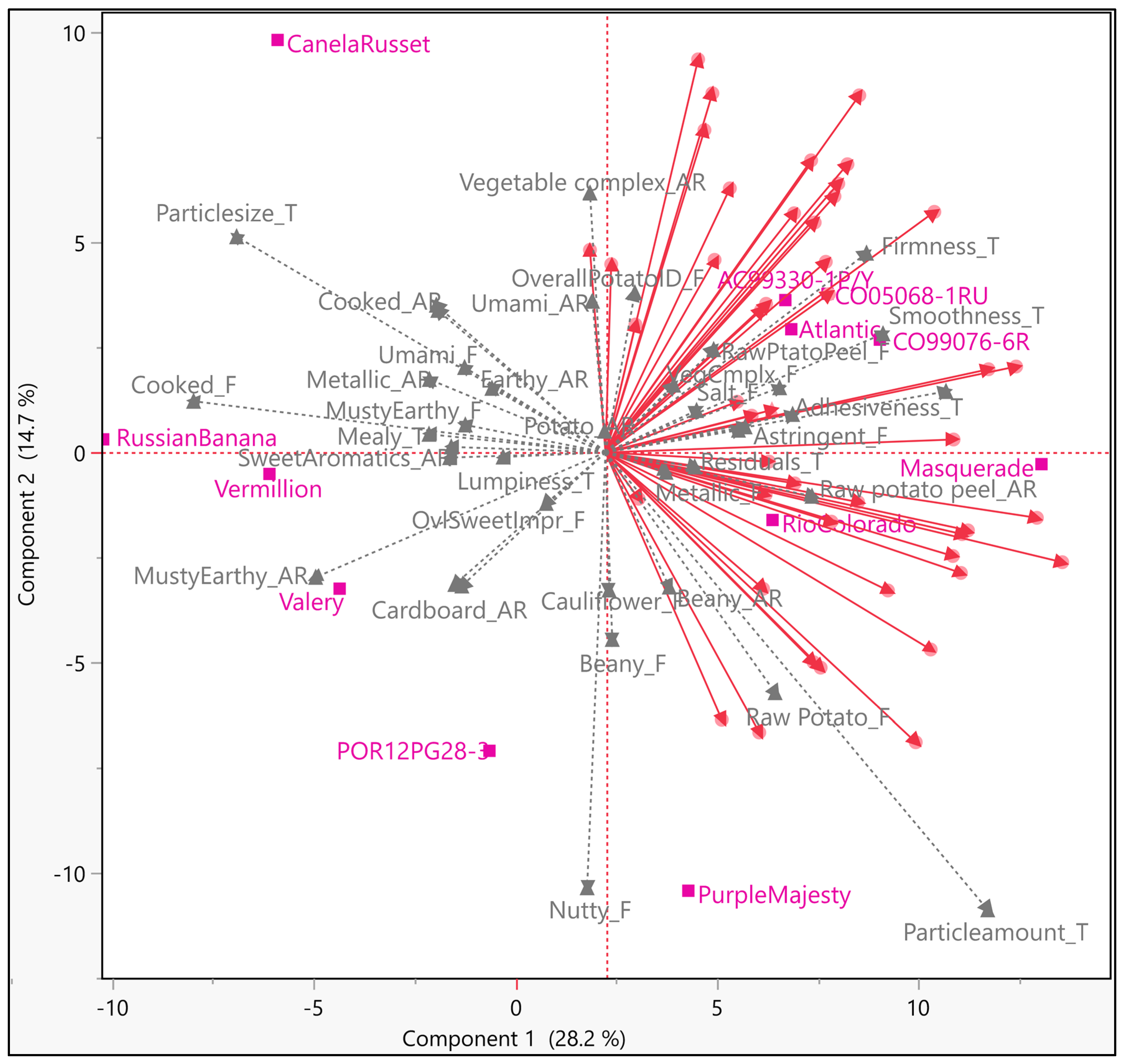
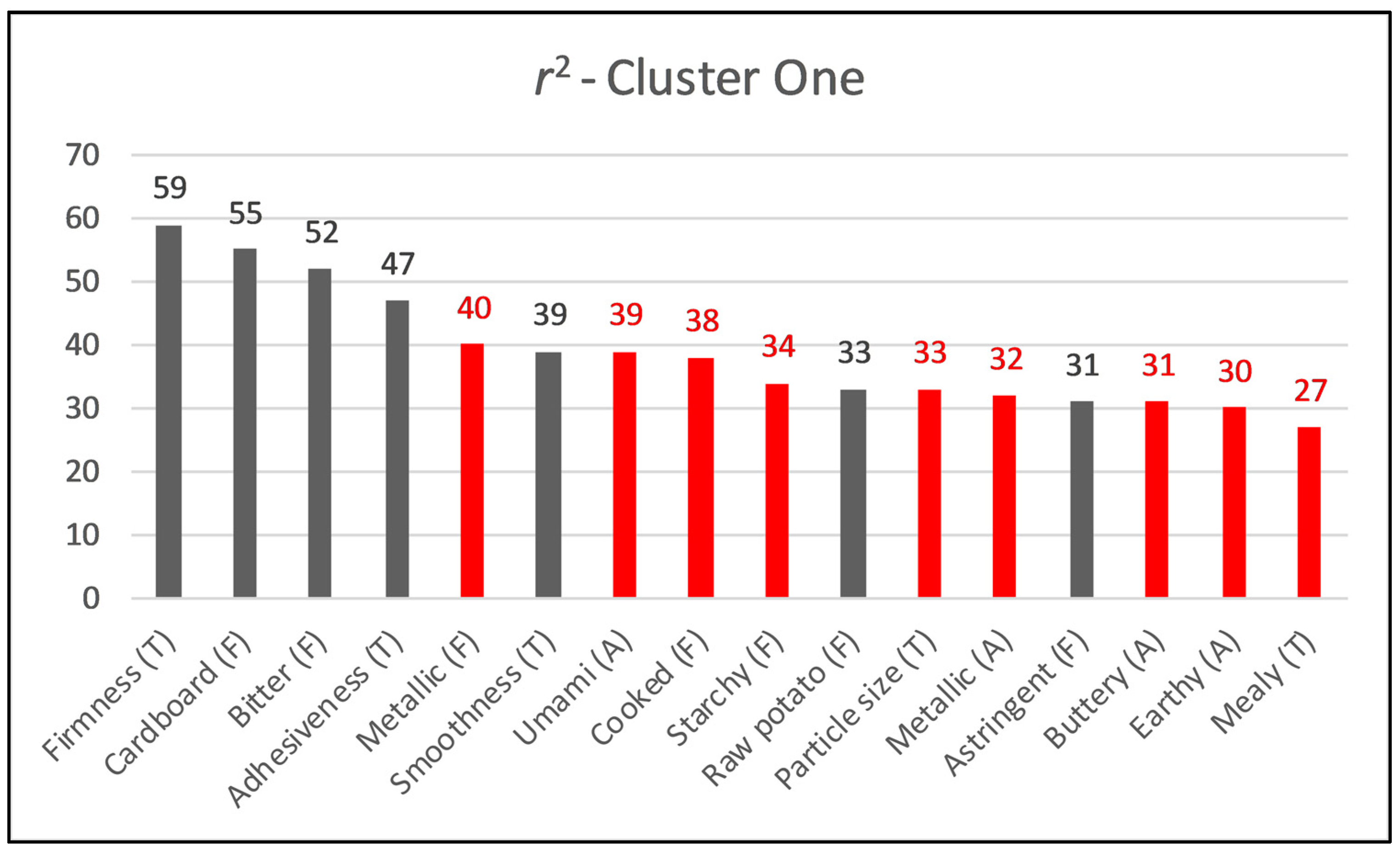
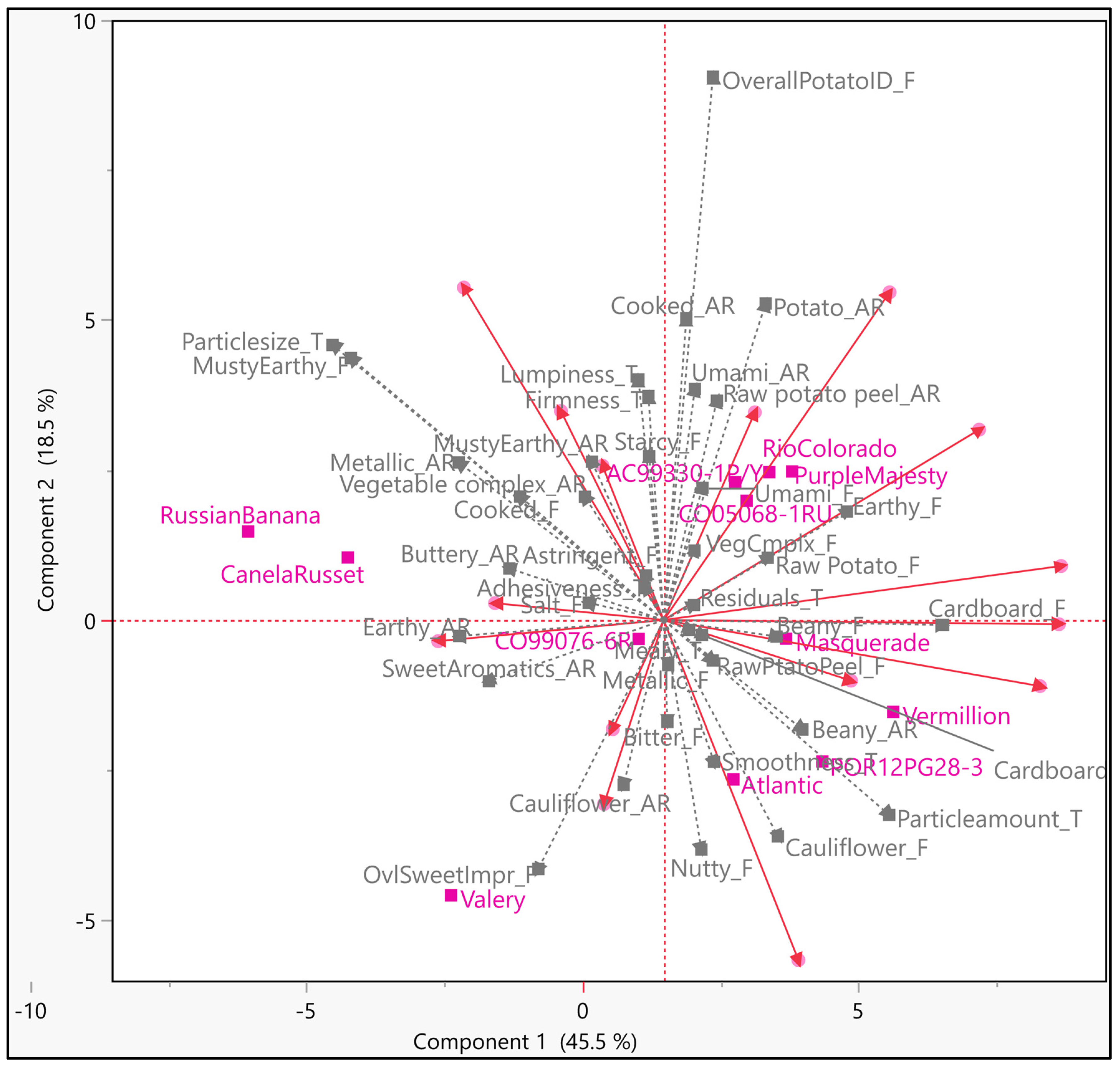
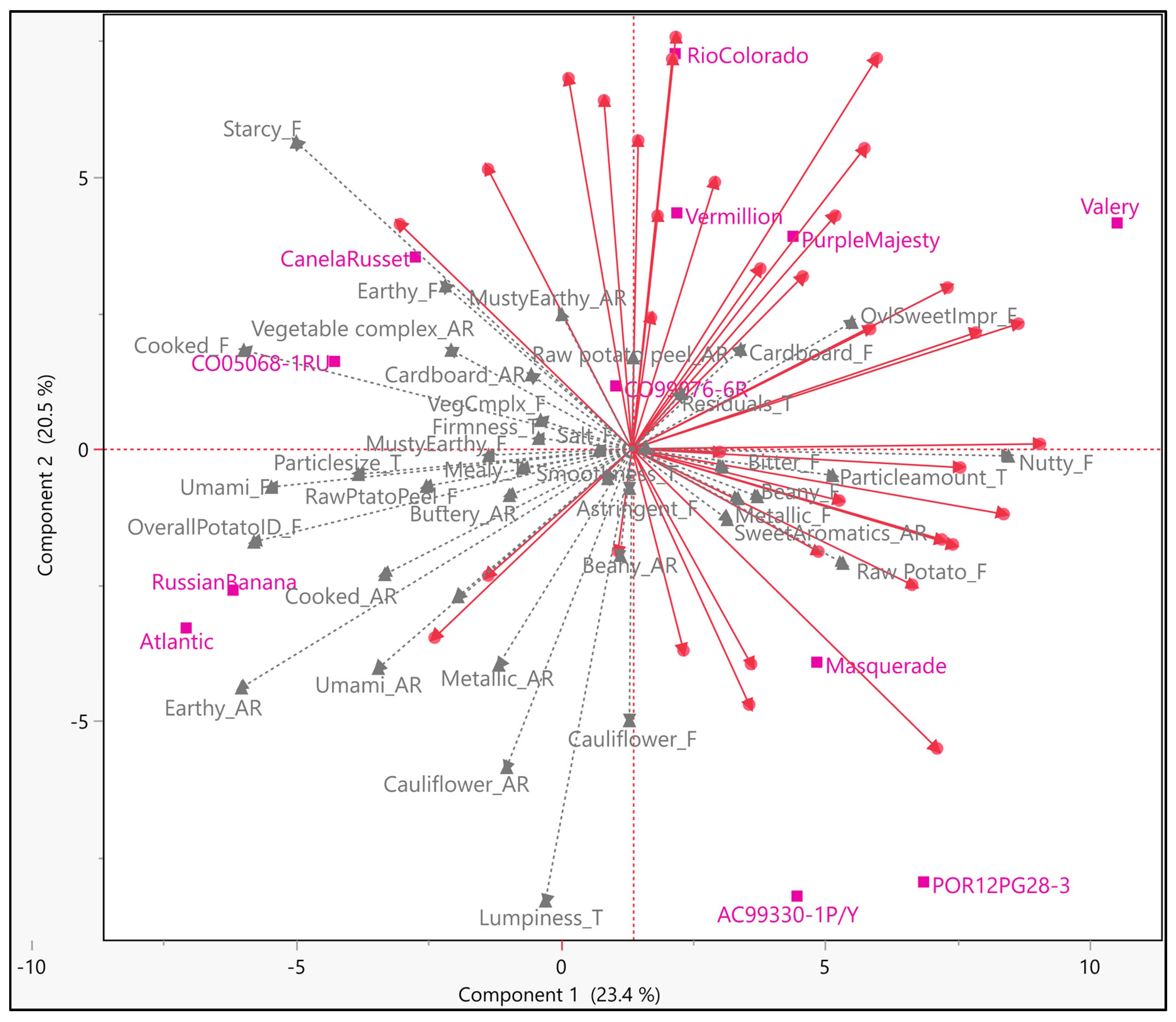
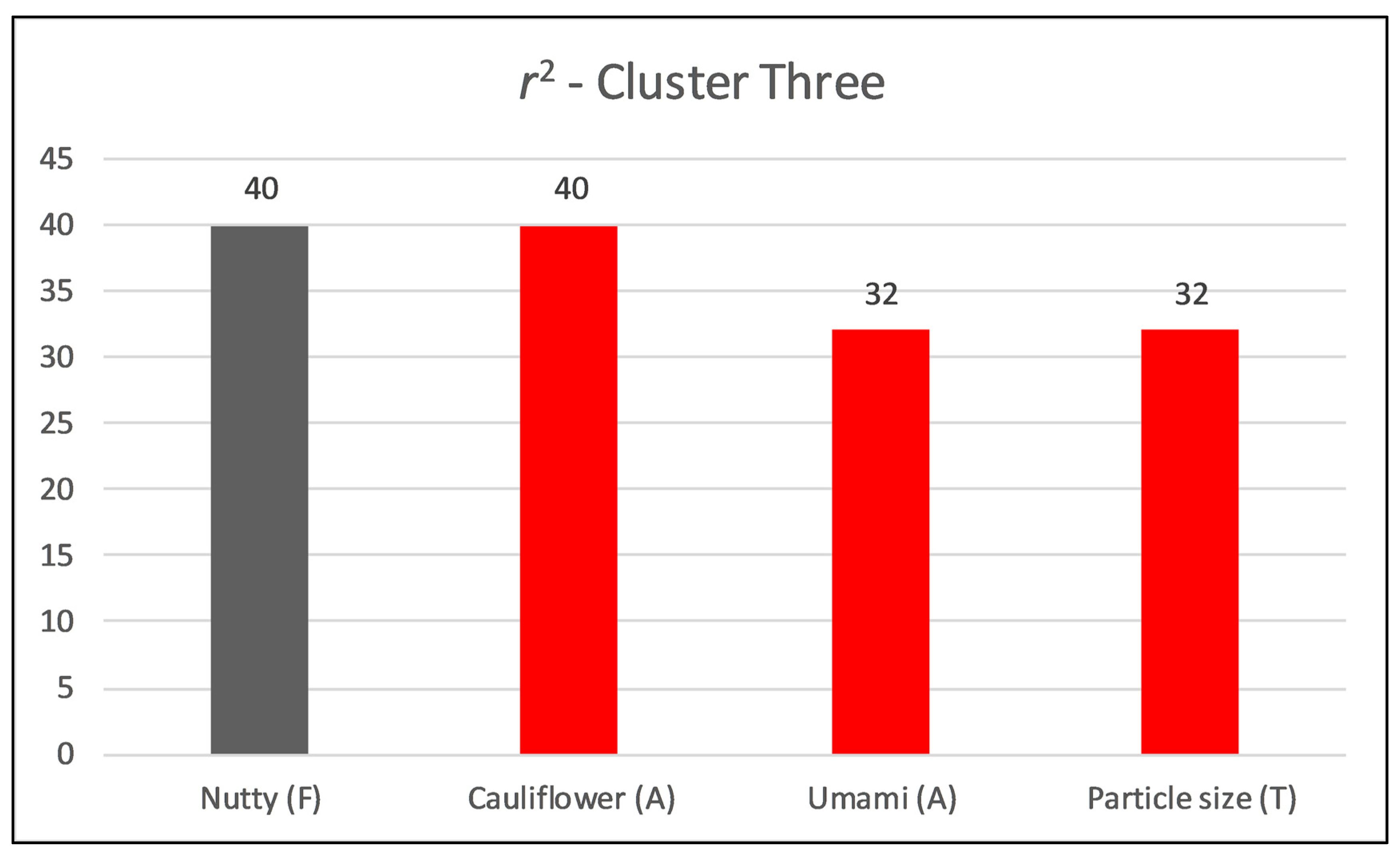
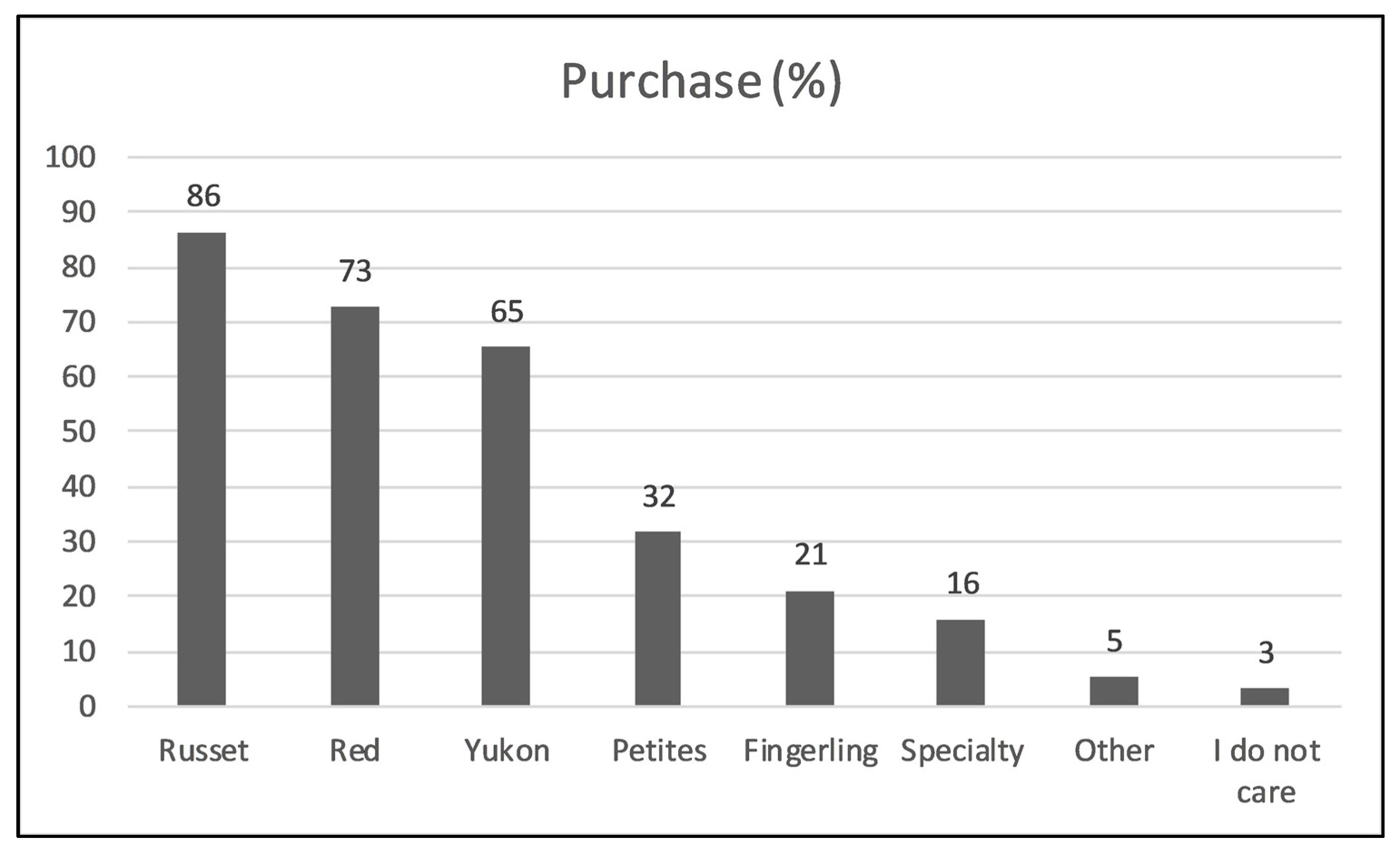
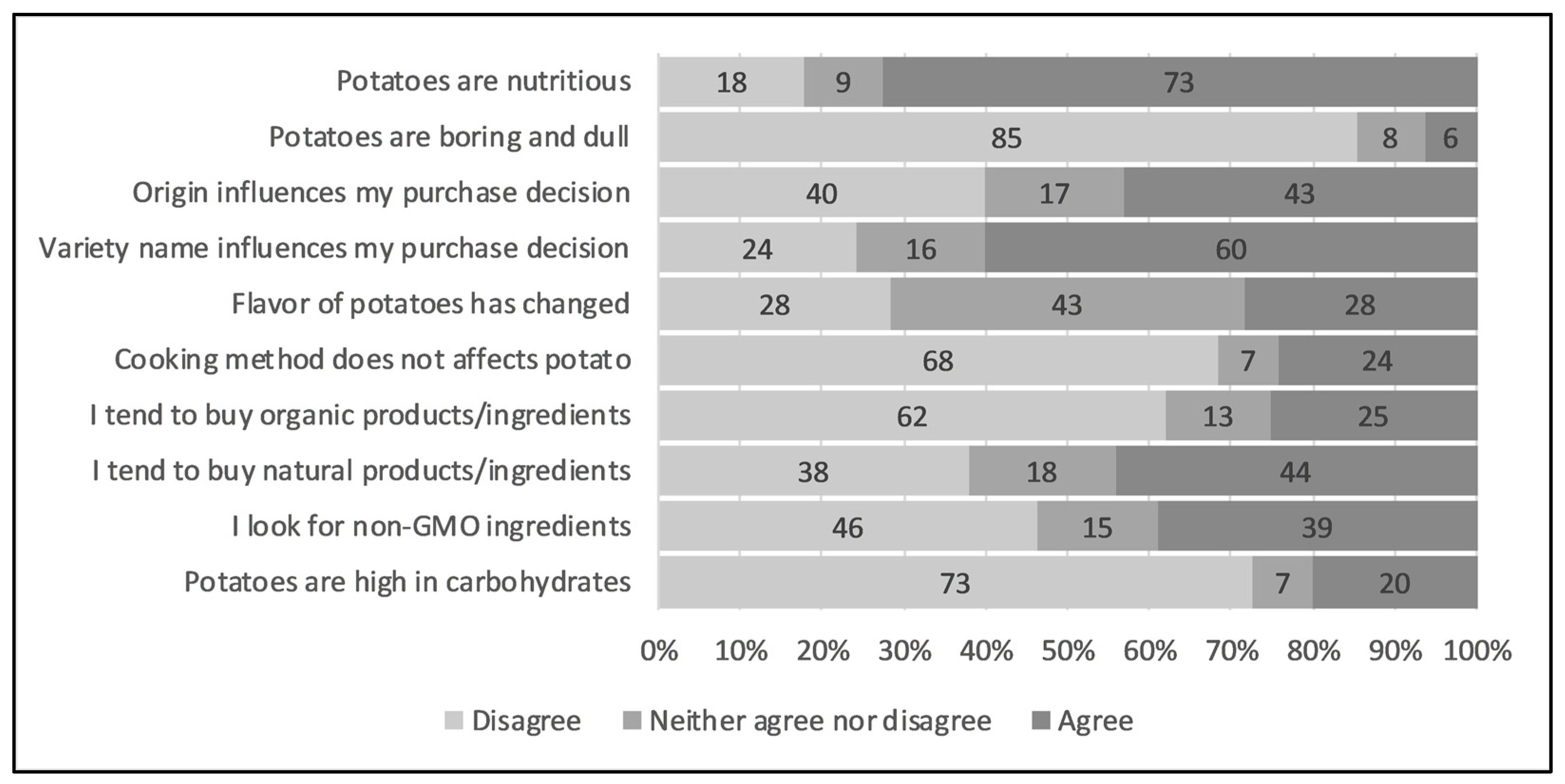
| S. No. | Clone | Type | Origin |
|---|---|---|---|
| 1 | CO05068-1RU | Russet | Colorado |
| 2 | Canela Russet | Russet | Colorado |
| 3 | Atlantic | Chip | Oregon |
| 4 | CO99076-6R | Red | Colorado |
| 5 | Rio Colorado | Red | Colorado |
| 6 | AC99330-1P/Y | Yellow | Colorado |
| 7 | Masquerade | Yellow | Colorado |
| 8 | Russian Banana | Fingerling | Oregon |
| 9 | POR12PG28-3 | Fingerling | Oregon |
| 10 | Purple Majesty | Purple | Oregon |
| 11 | Vermillion | Specialty | Oregon |
| 12 | Valery | Specialty | Oregon |
| Factors Influencing Purchase Decision | Median | Importance |
|---|---|---|
| Size | 3 | Highly important |
| Price | 3 |  |
| Color of Peel | 4 | |
| Shape | 5 | |
| Variety | 5 | |
| Locally produced | 6 | |
| Packaging | 7 | |
| Nutritional Information | 7 | |
| Organic | 8 | Least important |
| Potato Preparation Method | Median | Importance |
|---|---|---|
| Baked | 2 | Highly important |
| Mashed | 2 |  |
| Fried | 3 | |
| Boiled | 4 | |
| Microwaved | 5 | |
| Other | 6 | Least important |
| Segment One (48%) | Segment Two (16%) | Segment Three (36%) | |
|---|---|---|---|
| Sensory/hedonic aspects | Overall, lowest liking for some samples | Overall, all of the tested samples were highly liked | Intermediate liking |
| Very narrow choice | Broad choice | Broad choice | |
| Highest liking (6.06) was reported for Masquerade | Highest liking (7.13) was reported for CO05068-1RU and Rio Colorado | Highest liking (6.06 and 5.97) was reported for Valery and Purple Majesty, Rio Colorado | |
| Russian Banana was least liked | Russian Banana was least liked | Russian Banana was least liked | |
| Lower hedonic score for colored varieties | Not much impact of color | Higher hedonic score for colored varieties | |
| Raw potato, earthy, cardboard, vegetable complex and typical potato flavor are key flavor attributes | No specific attributes are associated with this segment | Sweet aromatics, nutty, and bitter are key flavor attributes | |
| Attitudinal aspects | Nutritional information matters | Nutritional information does not matter as much | Nutritional information matters |
| Some boredom associated with potatoes | No boredom | Some boredom associated with potatoes | |
| Origin does not matter as much | Origin matters | Origin matters | |
| Variety name matters | Variety name does not matter as much | Variety name matters | |
| Package information is important | No impact of package information | Package information is highly important | |
| Potato flavor has not changed much historically | Believes that potato flavor has changed historically | Potato flavor has not changed much historically | |
| Cooking method affects potato nutrition | Cooking method does not impact potato nutrition | Cooking method affects potato nutrition | |
| Organic, natural are least important | Organic, natural are important | Organic, natural are important | |
| Not as much opposition to GMO | Non-GMO supporter | Not as much opposition to GMO | |
| Consumer Segments | Price oriented, conventional potato user group | Blind potato lovers’ group | Health oriented, acceptor of new color varieties group |
© 2020 by the authors. Licensee MDPI, Basel, Switzerland. This article is an open access article distributed under the terms and conditions of the Creative Commons Attribution (CC BY) license (http://creativecommons.org/licenses/by/4.0/).
Share and Cite
Sharma, C.; Jayanty, S.S.; Chambers, E., IV; Talavera, M. Segmentation of Potato Consumers Based on Sensory and Attitudinal Aspects. Foods 2020, 9, 161. https://doi.org/10.3390/foods9020161
Sharma C, Jayanty SS, Chambers E IV, Talavera M. Segmentation of Potato Consumers Based on Sensory and Attitudinal Aspects. Foods. 2020; 9(2):161. https://doi.org/10.3390/foods9020161
Chicago/Turabian StyleSharma, Chetan, Sastry S. Jayanty, Edgar Chambers, IV, and Martin Talavera. 2020. "Segmentation of Potato Consumers Based on Sensory and Attitudinal Aspects" Foods 9, no. 2: 161. https://doi.org/10.3390/foods9020161
APA StyleSharma, C., Jayanty, S. S., Chambers, E., IV, & Talavera, M. (2020). Segmentation of Potato Consumers Based on Sensory and Attitudinal Aspects. Foods, 9(2), 161. https://doi.org/10.3390/foods9020161







